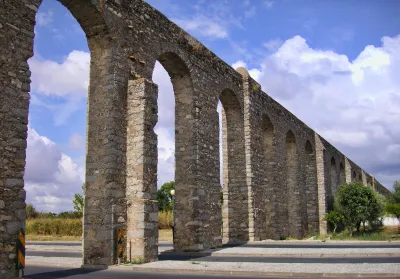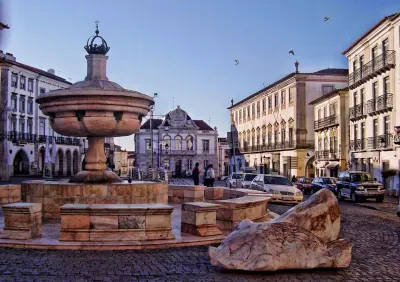Agua de Prata Aqueduct

Literally meaning the "Aqueduct of Silver Water", the Agua de Prata Aqueduct is an incredible testament to 16th century engineering. It was built to ensure that the strategically important citadel of Elvira would not run out of clean drinking water during the hot, dry summers. King John III of Portugal appointed Francisco de Arruda, who had built Lisbon's Belem Tower to oversee the project, which took six years to construct, finally opening in 1537.
Évora Roman Temple

The Roman Temple of Évora is said by some to be the best-preserved Roman structure on the Iberian Peninsula. It was once thought to be the Temple of Diana, the goddess of hunting, and many still call it by this name, but this attribution appears to date back to the views of a 17th century priest, without any historical or archaeological foundation. Most now agree that the temple was built around the first century A.D.
Évora Cathedral

Évora's imposing cathedral (Sé Catedral de Évora) is situated in the very heart of the old city and the UNESCO World Heritage site. The oldest parts of the building date back to the 12th century, which was when the Moors were finally driven out by the Christians. As a consequence it is no coincidence that this mighty cathedral has certain aspects which resemble a fortress. Probably most people's first view of the cathedral is the façade which looks out over the Évora's main square.
Praça do Giraldo

Praca do Giraldo - Evora's main square, with its picturesque stone arches, is flanked by some fine examples of Romanesque and Gothic architecture. This place is central to the city's life and this is where tourists can mingle with locals in the cafes and restaurants which line the square. It is a great place for sitting and watching the world go by.
Capela dos Ossos, Évora

The Medieval Capela dos Ossos (Chapel of Bones) in Evora is a spectacularly morbid celebration of death. As such it is one of Évora's most popular attractions.
Located within the huge, Gothic church of São Francisco, the Chapel of Bones is everything its name suggests. A vaulted ceiling supported by eight columns is about the only part of the chapel that is not covered in the human skulls and bones. It is estimated that there are over 5,000 skulls decorating the chapel many of which were dug up from the many monastic cemeteries in the area.
Almendres Cromlech

Whilst Évora may be able to boast some quite impressive historic credentials there is a site, less than half an hour's drive away that predates anything in the city by thousands of years. Built in the early Stone Age the Almendres Cromlech (Cromleque dos Almendres) dates back over 6,000 years. But it isn't just the age which is impressive - this is the largest megalithic site to be found anywhere on the Iberian Peninsula. Although not quite of the scale of Carnac in Britanny, Almendres is far more atmospheric.
